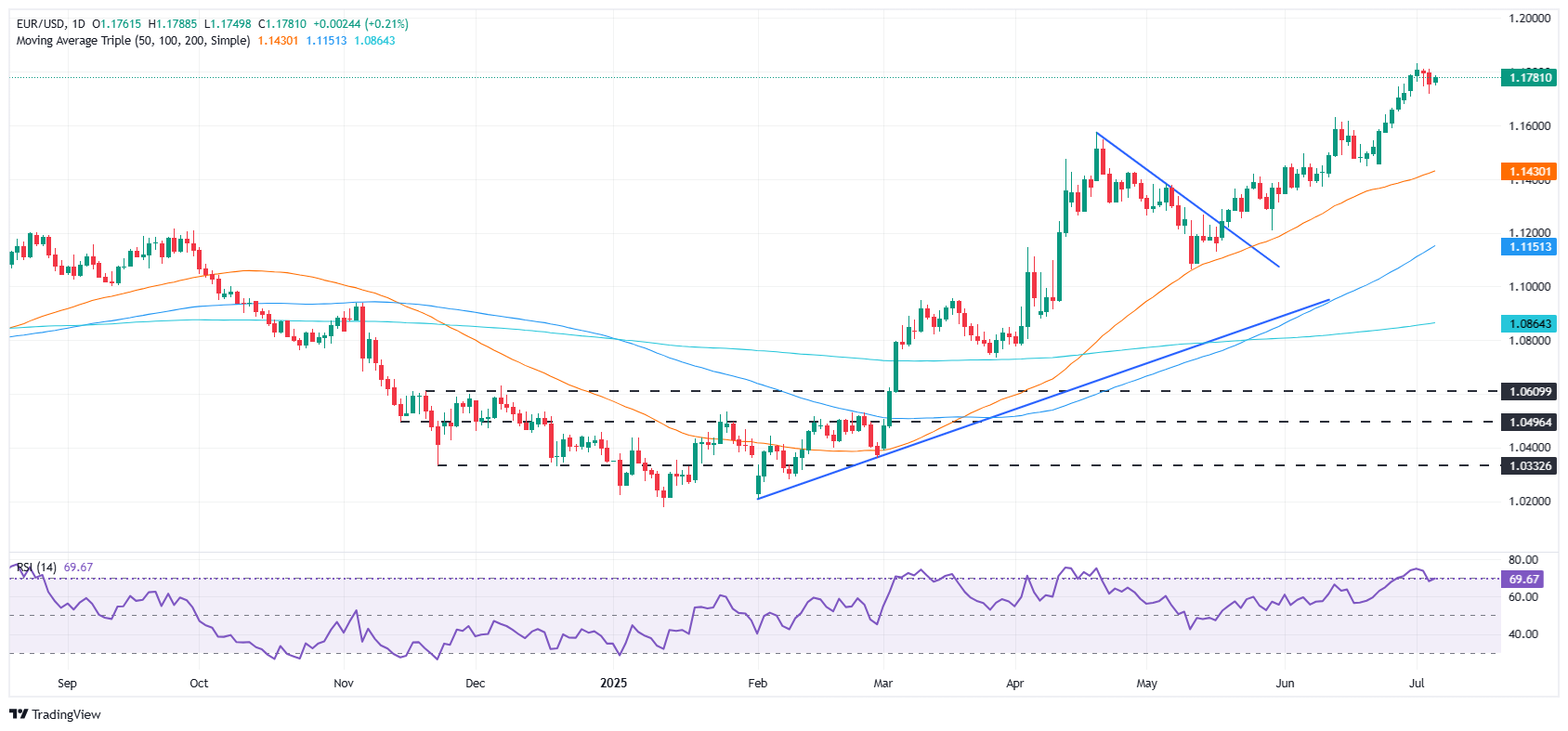
- EUR/USD edges up 0.18% in thin trading as traders digest Trump’s sweeping tariff plans and EU–US tensions mount.
- Trump confirms tariffs up to 70% to take effect August 1, targeting EU goods, including food.
- Bloomberg: EU carmakers seek tariff relief via US investment pledges.
- Light US calendar shifts focus to German industrial output and Eurogroup meeting next week.
EUR/USD posted minimal gains of 0.18% on Friday amid thin liquidity conditions, as markets in the United States are closed due to the Independence Day holiday. The shared currency is poised to close the week with gains of 0.53% despite the release of solid US economic data this week. At the time of writing, the pair trades at 1.1778.
Economic news is scarce on Friday, still, market participants turned their attention to tariffs and the approval of US President Donald Trump’s ‘One Big Beautiful Bill.’
On Thursday, Trump announced that the United States would begin issuing declaration letters, notifying countries that tariffs are being applied to their goods and services. He added that the duties could be within the 10% to 70% range and would take effect on August 1. In the meantime, tensions around a Europe-US trade deal are rising, as Washington announced a 17% duty on European food.
In the meantime, Bloomberg reported that “Some European Union carmakers and capitals are pushing for an agreement with President Donald Trump that would allow for tariff relief in return for increasing investment in the US, according to people familiar with the matter.”
An absent economic docket in the US left EUR/USD traders adrift as they turned to the European Union’s (EU) docket. German Industrial orders fell below estimates in May every month, but compared to the figures from the same month in the previous year, showed a slight improvement.
Following Monday, the EU docket will feature German Industrial Production figures, the Eurogroup meeting, ECB speakers, and the announcement of Retail Sales data for May.
Daily digest market movers: EUR/USD climbs on light economic calendar
- US President Trump said his administration would begin notifying countries of new US tariffs on their exports, effective August 1. He said that about ten to twelve letters would be sent out on Friday. Additional letters will be distributed in the coming days, ahead of the July 9 deadline.
- The ‘One Big Beautiful Bill’ approved by the US Congress will add $3.4 trillion over a decade to the national deficit. The bill aimed to extend the tax cuts implemented in 2017 and allocate billions of dollars to defense and immigration enforcement. At the same time, it slashes some health care programs, food assistance, and clean energy projects.
- A Bloomberg article revealed that the EU and the US are nearing a technical trade agreement in principle. The EU hinted that they’re willing to accept a 10% universal tariff but in exchange for lower rates on pharmaceuticals, alcohol, semiconductors, and aircraft. They’re also seeking quotas and exemptions to lower current tariffs on cars, steel, and aluminum. Negotiations between both parties will continue over the weekend.
- German Factory Orders in May plunged 1.4% MoM from 1.6% expansion in April. In the twelve months to May, it dipped from 5.8% to 5.3%, revealed the Deutsche Bundesbank.
Euro technical outlook: EUR/USD bounces towards 1.1780 as bulls eye 1.1800
The EUR/USD is trading sideways on Friday and is poised to form a ‘bullish harami’ candlestick pattern, which hints, that the uptrend in the long-term remains intact. Nevertheless, a clear break of the July 3 high of 1.1809 is needed, ahead of testing the yearly high of 1.1830. Once those levels are cleared, the next stop would be 1.1850 and 1.1900.
Conversely, if EUR/USD tumbles below 1.1750, it opens the door to a potential decline to 1.1700. In the event of further weakness, the next support level will be the June 12 high at 1.1631.

Euro FAQs
The Euro is the currency for the 19 European Union countries that belong to the Eurozone. It is the second most heavily traded currency in the world behind the US Dollar. In 2022, it accounted for 31% of all foreign exchange transactions, with an average daily turnover of over $2.2 trillion a day. EUR/USD is the most heavily traded currency pair in the world, accounting for an estimated 30% off all transactions, followed by EUR/JPY (4%), EUR/GBP (3%) and EUR/AUD (2%).
The European Central Bank (ECB) in Frankfurt, Germany, is the reserve bank for the Eurozone. The ECB sets interest rates and manages monetary policy. The ECB’s primary mandate is to maintain price stability, which means either controlling inflation or stimulating growth. Its primary tool is the raising or lowering of interest rates. Relatively high interest rates – or the expectation of higher rates – will usually benefit the Euro and vice versa. The ECB Governing Council makes monetary policy decisions at meetings held eight times a year. Decisions are made by heads of the Eurozone national banks and six permanent members, including the President of the ECB, Christine Lagarde.
Eurozone inflation data, measured by the Harmonized Index of Consumer Prices (HICP), is an important econometric for the Euro. If inflation rises more than expected, especially if above the ECB’s 2% target, it obliges the ECB to raise interest rates to bring it back under control. Relatively high interest rates compared to its counterparts will usually benefit the Euro, as it makes the region more attractive as a place for global investors to park their money.
Data releases gauge the health of the economy and can impact on the Euro. Indicators such as GDP, Manufacturing and Services PMIs, employment, and consumer sentiment surveys can all influence the direction of the single currency. A strong economy is good for the Euro. Not only does it attract more foreign investment but it may encourage the ECB to put up interest rates, which will directly strengthen the Euro. Otherwise, if economic data is weak, the Euro is likely to fall. Economic data for the four largest economies in the euro area (Germany, France, Italy and Spain) are especially significant, as they account for 75% of the Eurozone’s economy.
Another significant data release for the Euro is the Trade Balance. This indicator measures the difference between what a country earns from its exports and what it spends on imports over a given period. If a country produces highly sought after exports then its currency will gain in value purely from the extra demand created from foreign buyers seeking to purchase these goods. Therefore, a positive net Trade Balance strengthens a currency and vice versa for a negative balance.
Information on these pages contains forward-looking statements that involve risks and uncertainties. Markets and instruments profiled on this page are for informational purposes only and should not in any way come across as a recommendation to buy or sell in these assets. You should do your own thorough research before making any investment decisions. FXStreet does not in any way guarantee that this information is free from mistakes, errors, or material misstatements. It also does not guarantee that this information is of a timely nature. Investing in Open Markets involves a great deal of risk, including the loss of all or a portion of your investment, as well as emotional distress. All risks, losses and costs associated with investing, including total loss of principal, are your responsibility. The views and opinions expressed in this article are those of the authors and do not necessarily reflect the official policy or position of FXStreet nor its advertisers. The author will not be held responsible for information that is found at the end of links posted on this page.
If not otherwise explicitly mentioned in the body of the article, at the time of writing, the author has no position in any stock mentioned in this article and no business relationship with any company mentioned. The author has not received compensation for writing this article, other than from FXStreet.
FXStreet and the author do not provide personalized recommendations. The author makes no representations as to the accuracy, completeness, or suitability of this information. FXStreet and the author will not be liable for any errors, omissions or any losses, injuries or damages arising from this information and its display or use. Errors and omissions excepted.
The author and FXStreet are not registered investment advisors and nothing in this article is intended to be investment advice.







